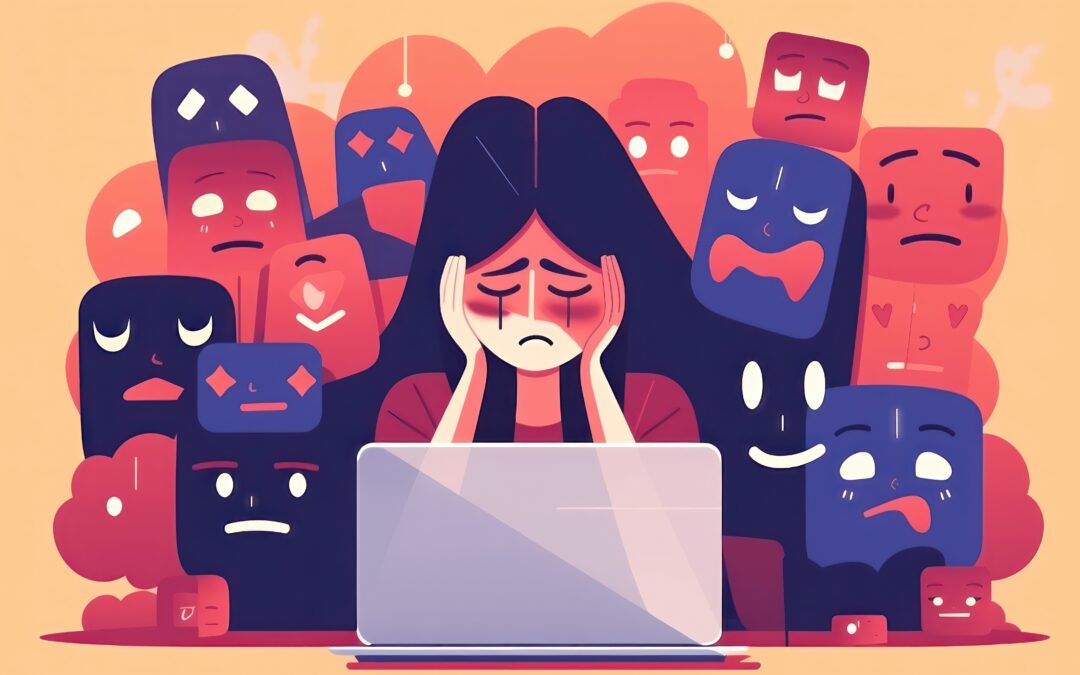In our digital era, where screens are gateways to endless social interactions, a sinister trend, known as cyberbullying, has emerged and escalated, leaving deep psychological scars in its wake. It’s a modern-day crisis intersecting with mental health issues, such as depression and, subsequently, substance abuse. As we navigate this interconnected labyrinth, we recognize that no one is immune. The consequences are far-reaching, emphasizing the urgency for awareness, early intervention, and comprehensive support systems.
Virtual Torment: Understanding Cyberbullying
Cyberbullying, a perilous frontier, involves the use of digital platforms to harass, threaten, or humiliate an individual. Unlike traditional bullying, it grants the perpetrator constant access to their victim and a shield of anonymity.
- Relentlessness: Digital spaces allow bullying to penetrate the sanctuary of the home, leaving victims feeling trapped, with no respite from the onslaught.
- Anonymity: Bullies often hide behind fake profiles, exacerbating the distress for victims who feel besieged by an invisible adversary.
- Public Sphere: The public nature of online platforms amplifies humiliation, with damaging content easily shared and viewed by vast audiences.
Cyberbullying’s Impact on Mental Health, Depression, and Substance Abuse
The psychological impact of this relentless digital persecution is profound, precipitating a spectrum of mental health issues, of which depression is a significant concern.
- Isolation: Victims often withdraw socially, exacerbating feelings of loneliness and making them susceptible to depressive states.
- Self-Esteem: Harassment and public shaming erode self-confidence, sometimes instilling a debilitating sense of worthlessness in the victim.
- Anxiety and Paranoia: Continuous bullying can induce heightened anxiety and paranoia, significantly disrupting daily functioning.
In this vulnerable psychological terrain, individuals, particularly adolescents and young adults, may turn to drugs or alcohol as a form of self-medication, seeking a refuge from emotional pain in substance abuse.
The Dark Nexus: From Depression to Addiction
Understanding the link between depression, stemming from cyberbullying, and substance abuse is crucial. Depression can drive an individual to seek solace in drugs or alcohol, establishing a destructive pattern.
- Escapism: For some, substances offer a temporary escape from the debilitating weight of depression, a momentary lapse from reality.
- Chemical Relief: Drugs and alcohol may seem to provide a temporary uplift in mood, a dangerous illusion that often leads to repeated use.
- The Vicious Cycle: Substance abuse complicates mental health issues, often deepening depression, creating a vicious cycle of addiction and emotional suffering.
This dangerous pathway highlights that anyone, regardless of age, gender, or socio-economic status, can fall prey to this domino effect of cyberbullying, leading to depression and then addiction.
Early Detection: Signs of Depression, Substance Abuse and Preventive Measures
Early intervention is crucial in preventing or mitigating the spiral from cyberbullying to depression and substance abuse. Recognizing the signs requires vigilance from both individuals and their support networks.
- Behavioral Changes: Notable shifts in behavior, such as withdrawal, sudden outbursts, or changes in eating and sleeping patterns, are critical initial signs.
- Academic/Professional Impact: Declining grades, decreased participation, or sudden disinterest in work or school activities can signal underlying distress.
- Substance Use: Discovery of substance use, particularly if it correlates with changes in behavior or mood, should be addressed immediately.
Implementing preventive strategies is equally vital:
- Open Communication: Foster a safe environment for open dialogue about online experiences and encounters. Victims of cyberbullying often suffer in silence.
- Monitoring: While respecting privacy, caregivers should monitor online activity, especially if behavioral changes are noted.
- Education: Raise awareness about cyberbullying, its consequences, and the importance of safe online practices.
Seeking Refuge: The Importance of Treatment
Acknowledging the problem and understanding its seriousness is the first step towards healing. The journey from victim to survivor requires a comprehensive approach.
- Professional Counseling: Therapy offers a platform for victims to process their experiences and develop coping strategies. In cases where substance abuse is present, specialized addiction counseling is necessary.
- Support Groups: Connection with others who have endured similar experiences can be profoundly healing. Support groups foster a sense of community and understanding.
- Family Involvement: Family therapy and support are integral to recovery. A united front can significantly bolster the individual’s healing process.
- School and Workplace Programs: Educational institutions and workplaces should have structured programs to address cyberbullying and provide support to those affected.
Building Resilience: Community and Social Responsibility
Combating cyberbullying and its domino effect on mental health and addiction is a collective responsibility. This endeavor requires a multi-faceted approach:
- Policy Implementation: Schools, universities, and workplaces need clear, enforceable policies against cyberbullying, along with accessible support resources.
- Legal Framework: Awareness of legal channels to address severe cases of cyberbullying is crucial. Legislation must evolve to protect victims and hold perpetrators accountable.
- Social Media Responsibility: Social platforms must take decisive action against cyberbullying, including proactive monitoring, user reporting mechanisms, and educational initiatives.
- Public Awareness Campaigns: Broad campaigns can raise public consciousness about the seriousness of cyberbullying and its impact on mental health.
Conclusion: A Call to Digital Empathy
In conclusion, our digital era, shimmering with promise and possibility, also harbors shadows. Cyberbullying represents a dark intersection of technology and human interaction, a phenomenon triggering a cascade of psychological distress, leading from depression to the dangerous escape of addiction.
This journey from darkness to light hinges on empathy, vigilance, and action. It relies on our collective commitment to nurturing supportive communities, both online and offline, and our willingness to reach out, speak up, and connect.
In this interconnected world, it’s time to recognize that safeguarding mental health is a communal responsibility transcending digital boundaries. Let this awareness ignite efforts to reclaim the internet as a space of connection, not division, empowering each person to emerge not as victims of the digital age, but as pioneers of a more empathetic cyber frontier.

